Santa Rosa, CA Pollen and Allergy Report for Summer 2023
Pollen Allergy Trends in Santa Rosa, CA
When is pollen lowest in Santa Rosa, CA?

February
Lowest month total PPM
Avg. PPM
When is pollen highest in Santa Rosa, CA?

May
Highest month total PPM
Avg. PPM
How does pollen in Santa Rosa, CA compare to California?
Santa Rosa has a lower average PPM than the state of California.
Santa Rosa yearly avg PPM:
California yearly avg PPM:
How does pollen in Santa Rosa, CA compare to the USA?
Santa Rosa has a lower average PPM than the USA.
Santa Rosa yearly avg PPM:
USA yearly avg PPM:
Is pollen worse this year in Santa Rosa, CA?
Spring 2023 was worse than spring 2022.
Spring 2023 PPM:
Spring 2022 PPM:
Average PPM in Santa Rosa, CA
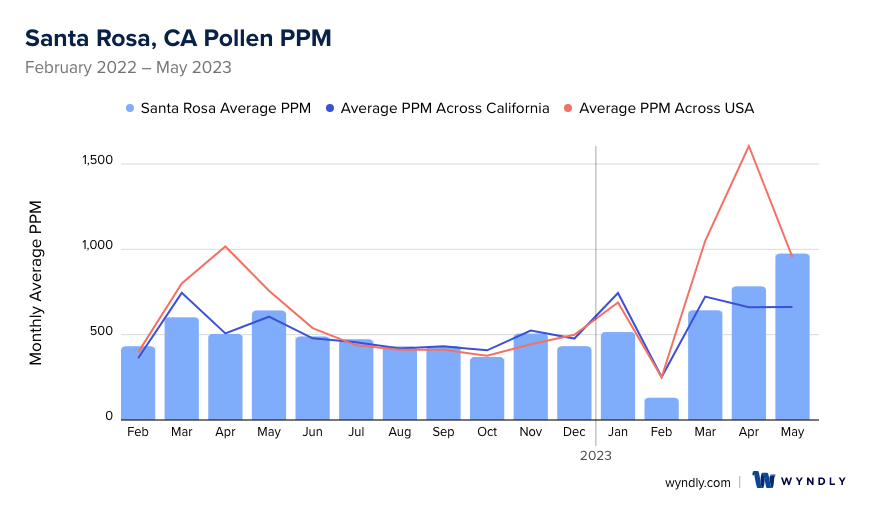
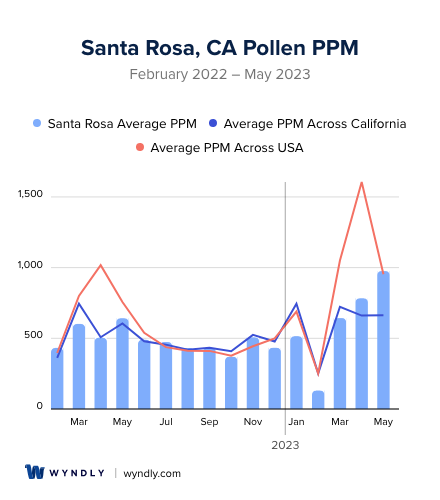
Santa Rosa, CA Pollen and Allergy Breakdown by Month
Grass
When is grass pollen highest in Santa Rosa, CA?
May has the highest grass pollen in Santa Rosa, CA with an average PPM of
When is grass pollen lowest in Santa Rosa, CA?
December has the lowest grass pollen in Santa Rosa, CA with an average PPM of
Tree
When is tree pollen highest in Santa Rosa, CA?
May has the highest tree pollen in Santa Rosa, CA with an average PPM of
When is tree pollen lowest in Santa Rosa, CA?
August has the lowest tree pollen in Santa Rosa, CA with an average PPM of
Weed
When is weed pollen highest in Santa Rosa, CA?
November has the highest weed pollen in Santa Rosa, CA with an average PPM of
When is weed pollen lowest in Santa Rosa, CA?
February has the lowest weed pollen in Santa Rosa, CA with an average PPM of
Santa Rosa, CA Pollen Monthly Breakdown by Pollen Type
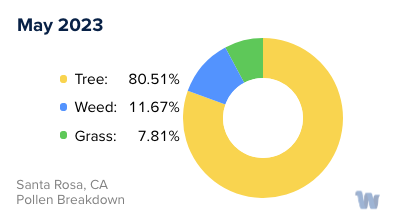
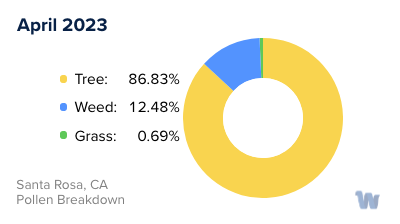
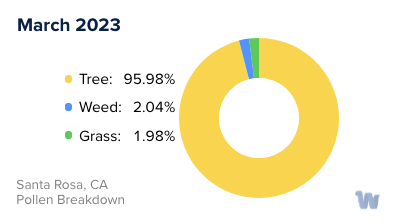
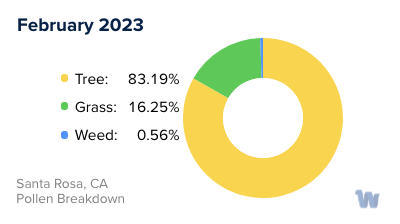
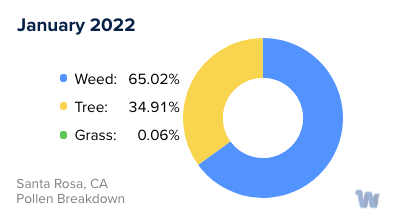
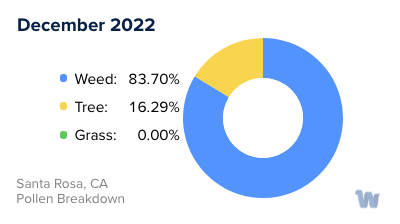
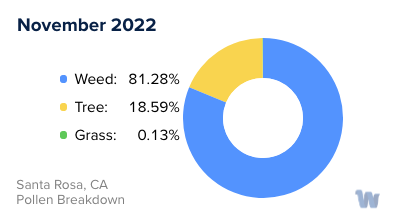

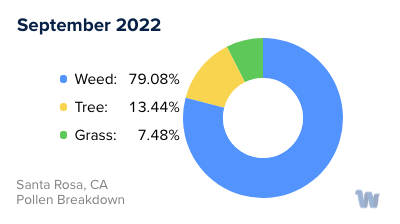
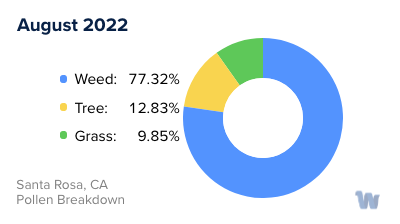
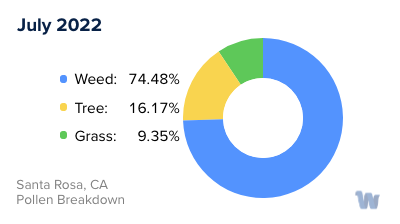
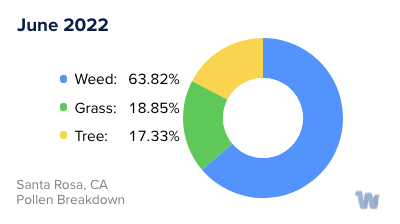
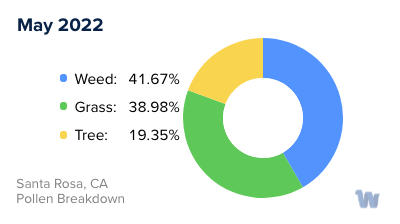
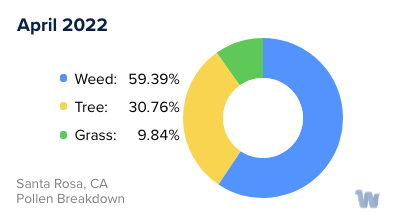
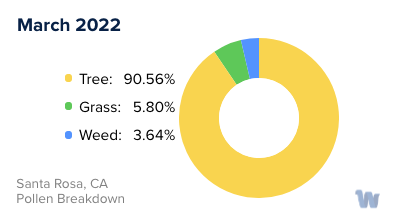
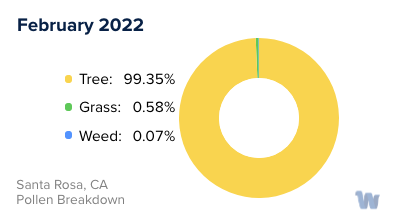
Pollen and Hay Fever in Santa Rosa, CA
Living in the beautiful city of Santa Rosa, California, it's hard to resist the allure of the great outdoors. But for some residents, venturing outside during certain times of the year can trigger an unwanted response: pollen allergies.
Pollen allergies, also known as hay fever or allergic rhinitis, occur when the immune system mistakenly identifies pollen as a harmful invader. In response, the body releases histamines that can cause symptoms such as sneezing, runny nose, itchy eyes, and throat discomfort. But not all pollen is created equal, and the types of pollen present in Santa Rosa can vary by season.
In spring, tree pollen is most prevalent. Oaks, which are abundant in Santa Rosa, are major pollen producers. Other common trees such as cedars, pines, and maples also contribute to the springtime pollen count. For those sensitive to tree pollen, spring can be a challenging time, as the pollen can travel on the wind for miles.
As the seasons shift from spring to summer, grass pollen takes center stage. Bermuda grass, ryegrass, and Timothy grass are all common in Santa Rosa and are known to be significant sources of pollen. These grasses typically release their pollen from late spring to early summer, and their pollen grains can be carried on the wind much like tree pollen.
Finally, as summer transitions into fall, weed pollen becomes the primary concern. Weeds such as ragweed, sagebrush, and lamb's quarters are common in the Santa Rosa area. These plants release their pollen in the late summer and fall, often peaking in August and September.
In summary, the types of pollen that trigger allergies in Santa Rosa change with the seasons, starting with tree pollen in the spring, transitioning to grass pollen in the summer, and ending with weed pollen in the fall. Understanding these patterns can help those with pollen allergies plan their outdoor activities and manage their symptoms more effectively, making the most of all that Santa Rosa has to offer.


